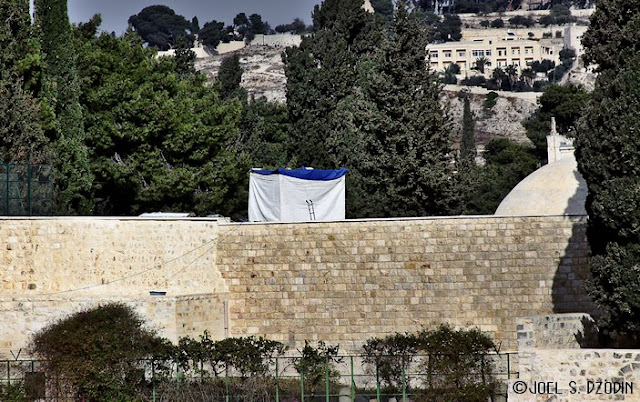The holiday of Succot ("Feast of Tabernacles") follows a few days after Yom Kippur. In Jerusalem, the sounds of hammering resounds through both the ultra-Orthodox Haredi and more heterogeneous neighborhoods, as people erect their Sukkot. In preparation for the holiday, an open-air market operates immediately across from the Machane Yehuda shuk, where vendors hawk the requisite Lulavim and Etrogim (Citron) which comprise the four species of plants required for ritual observance during Sukkot.
According to Wikipedia (http://en.wikipedia.org/wiki/Lulav):
"A lulav...must meet certain specifications in order to be kosher and permissible to be used to fulfill the commandment of the four species. Ideally, a lulav consists of a tightly closed frond of the date palm tree.To qualify, the lulav must be ramrod straight, with whole leaves that lay closely together, and not be bent or broken at the top. The twin middle-most leaves, which naturally grow together and are known as the tiyomet (תיומת, "twin"), should ideally not be split at all; however, the lulav remains kosher as long as the twin middle leaves are not split more than a handbreadth, approximating 3-4 inches.
The term lulav also refers to the lulav in combination with two of the other species—the aravah and the hadass—that are bound together to perform the mitzvah of waving the lulav. These three species are held in one hand while the etrog is held in the other. The user brings his or her hands together and waves the species in all four directions, plus up and down, to attest to God's mastery over all of creation. This ritual also symbolically voices a prayer for adequate rainfall over all the Earth's vegetation in the coming year..."
The following images were shot last night (September 19, 2010), using available incandescent light, as the Shuk was crowded with shoppers critically examining the ritual fitness of the lulavim and etrogim. Because there were several religious photography students shooting photos, the Haredi shoppers who normally resent photographers were actually posing for the students.
 |
| Etrogim in the Shuk |
During the intermediate days of Sukkot, Jerusalem fills with dense crowds of worshipers and visitors, resulting in serious traffic jams and altered bus routes. Where there are crowds, the need for security increases, and the police have been out in force during the holiday. Here are a few images from Sunday, September 26, 2010:
 |
| Security detail in the Kotel Plaza. |
 |
| Away from the surging nearby crowds, a Sukkah in the Davidson Archaeological Gardens, adjacent to the Kotel. |
 |
| A note to be placed among the Kotel's stones. |
 |
| Approaching the Kotel. View of the uppermost part of Temple Mount, Jerusalem, October 27, 2010 |
Postscript:
Immediately after the Six-Day War of 1967, General Moshe Dyan decided to cede control of the Temple Mount precinct to the Waqf (the Muslim religious authorities in Jerusalem). This is a decision that many have come to regret. The Waqf rules the area with a heavy hand and any non-Muslim visitors suspected of the slightest outward display of active religious devotion (body motion, lips moving silently, etc) are immediately surrounded and ejected from the mountain.
So it was very strange to see what appeared to be a small Sukkah standing freely in the area between the Dome of the Rock and El Aksa mosques. Of course, it wasn't really a Sukkah but more probably a visual curtain to prevent people from seeing the extensive illegal and damaging excavations that have been conducted by the Waqf over the last several years.
But it was, even if only for a fleeting moment, an image of how things could be one day, when we've managed to forge a true peace of mind and spirit. But I'm afraid this will require divine intervention.





